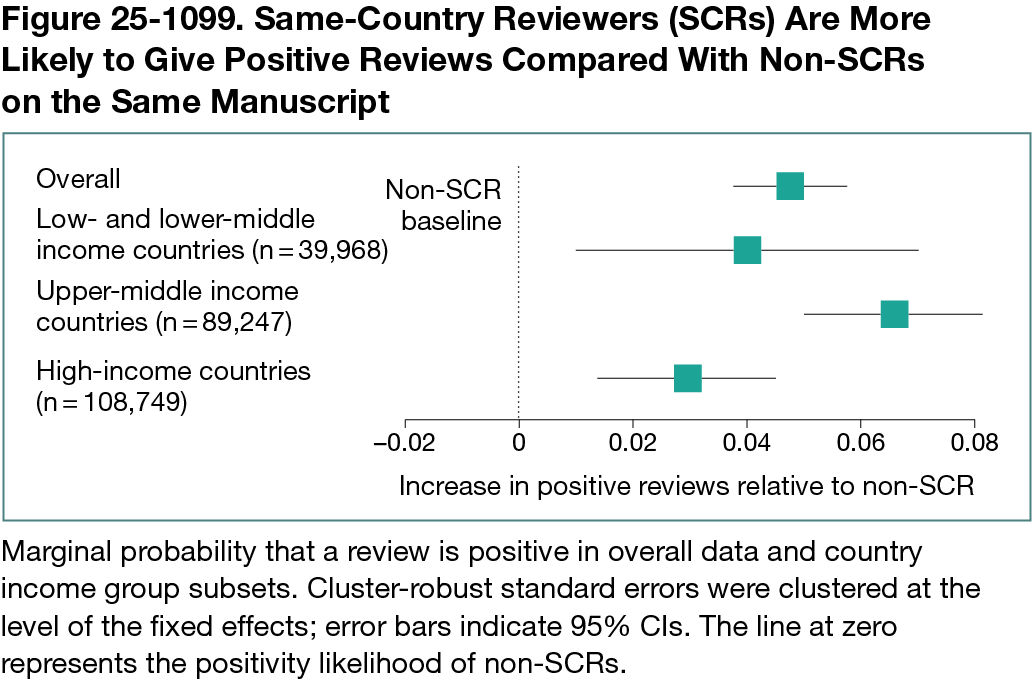Abstract
Geographical Representation of Author Country Among Peer Reviewers and Publishing Success at 60 STEM Journals
James M. Zumel Dumlao,1 Misha Teplitskiy1
Objective
This study tested whether (1) peer reviewers from the same country as the corresponding author are more favorable compared with those from a different country and (2) corresponding authors have differential access to these same-country reviewers (SCRs). While reviewer geographic diversity was previously considered,1,2 attempts to establish same-country preferences were confounded2 or had small samples.3
Design
This cross-sectional study (using the STROBE reporting guideline) took place from October 2022 to May 2025. Using metadata from 204,718 submissions to 60 STEM journals published by the Institute of Physics Publishing from 2018 to 2022, the study employed linear models with fixed effects and t tests for significance at the 1% level. Standard errors were clustered at the level of the fixed effects. Only first-round reviews were included to avoid autocorrelation (2.10 first-round reviewers per submission on average; 14.67% were SCRs). Fixed effects limit analysis to within-group comparisons. For example, manuscript fixed effects control for time-invariant variation across manuscripts like quality and proportion of SCRs on the review panel. To test the first hypothesis, this study compared the likelihood of a positive review (outcome) between SCRs and non-SCRs (exposure) using manuscript and reviewer fixed effects. Review positivity is equal to 0 if a reviewer recommended to reject the submission and 1 otherwise. To test the second hypothesis, this study estimated the likelihood a reviewer is an SCR (outcome) by corresponding author country income category (exposure) using journal fixed effects and controls for logged team size and anonymization status. Of 156 corresponding author countries, 60 were high-income countries (HIC), 39 were upper-middle income (UMIC), and 57 were low- and lower-middle income (LLMIC), according to World Bank classification.
Results
SCRs were more likely to give positive reviews compared with non-SCRs on the same manuscript (4.78 percentage points higher [95% CI, 3.78-5.78]; n = 181,228). Estimates of relative SCR positivity were positive for all country income groups (Figure 25-1099). HIC authors received SCRs over twice as often as LLMIC authors (4.97% [95% CI, 3.50%-6.44%] vs 2.66% [95% CI, 1.41%-3.91%]; n = 237,823). Authors from countries most represented among reviewers—the US, China, and India—had the greatest likelihood of receiving SCRs (30.27% [95% CI, 30.26%-30.28%], 26.59% [95% CI, 24.41%-28.77%], and 13.69% [95% CI, 10.77%-16.61%], respectively; n = 237,823).
Conclusions
Lack of geographical diversity among reviewers—possibly reflecting historical patterns of scientific production associated with country wealth—may introduce structural advantages if reviewers favor work from their own country, as this study demonstrated. However, diversification may be challenging if qualified reviewer capacity is low in underrepresented countries. Further research should examine generalizability across fields and test potential remedies.
References
1. Smith OM, Davis KL, Pizza RB, et al. Peer review perpetuates barriers for historically excluded groups. Nat Ecol Evol. 2023;7(4):512-523. doi:10.1038/s41559-023-01999-w
2. Murray D, Siler K, Larivière V, et al. Author-reviewer homophily in peer review. scientific communication and education bioRxiv. 2018. doi:10.1101/400515
3. Tomkins A, Zhang M, Heavlin WD. Reviewer bias in single- versus double-blind peer review. Proc Natl Acad Sci USA. 2017;114(48):12708-12713. doi:10.1073/pnas.1707323114
1University of Michigan School of Information, Ann Arbor, MI, US, jamesmzd@umich.edu.
Conflict of Interest Disclosures
None reported.
Funding/Support
This study received funding from the Institute of Physics Publishing, Schmidt Futures, and Science for Progress Initiative.
Role of the Funder/Sponsor
The Institute of Physics Publishing was involved in the collection, management, analysis, and interpretation of the data and preparation, review, or approval of the abstract. Schmidt Futures and Science for Progress Initiative contributed personnel funding.
Acknowledgment
We thank the Institute of Physics Publishing, and particularly Kim Eggleton and Mikka Pers, for supporting this project. We thank Schmidt Futures and the Science for Progress Initiative for financial support.

